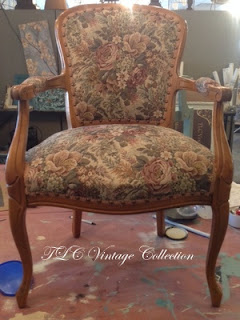I love to find steals like this at a garage or estate sale for a song! Others will pass by this dated upholstery leaving the pickings for me! The chair's great bones are just what I like and so we are off to a transformation!
On chairs like this with a brocaded type of coarse raised texture, I take my time when using Chalk Paint® decorative paint by Annie Sloan. I am trying to stain the fabric, rather than paint it. Put on too much paint too fast and the paint will crack and chip on you. But when you take your time, here is what can happen!
First, we did a custom mix of 50 pct Old White and 50 pct Coco to try to create a color that was like a pale burlap. Make sure to make up enough as it is difficult even with measuring to get back to the same color. Next we lightly spritz a small area to work on with a misting of water -- do not saturate the upholstery. Next, using a fluffy brush, we dip the ends of the bristles in water, then into our paint. With a light touch we whisper the paint onto the misted area. We repeat this process all over the chair then let it dry thoroughly, several hours or overnight.
When dry, we lightly sand with 200 grit sandpaper, then remove all the dust. Once again we repeat the process above as many times as necessary to get the coverage we want. In this particular case, it took four coats. After sanding and dusting off the final time, we are ready to paint the wood with Annie Sloan's lovely Old White. Two coats usually does it, especially if you plan to distress. We also attached a stencil with Frogtape, and using a stencil brush and Old White again created this Queen Bee chair!
Next we gently and lightly waxed the entire chair -- fabric and wood -- with Annie Sloan's Clear Soft Wax. We and removed the excess as we worked small areas. The final steps were to distress the wood lightly as well as a few of the brass upholstery tacks -- which had also been painted over -- then rewax any distressed parts.
I don't always wax painted upholstery. On this type of fabric, I do as it softens the feel. However, if I am painting a smooth fabric, such as a satin, I will sand it between coats of paint and after the last one. Then to give it some protection from dirt and grime, I spray it -- per can instructions -- with Scotch Guard, being careful not to get it on waxes areas.




